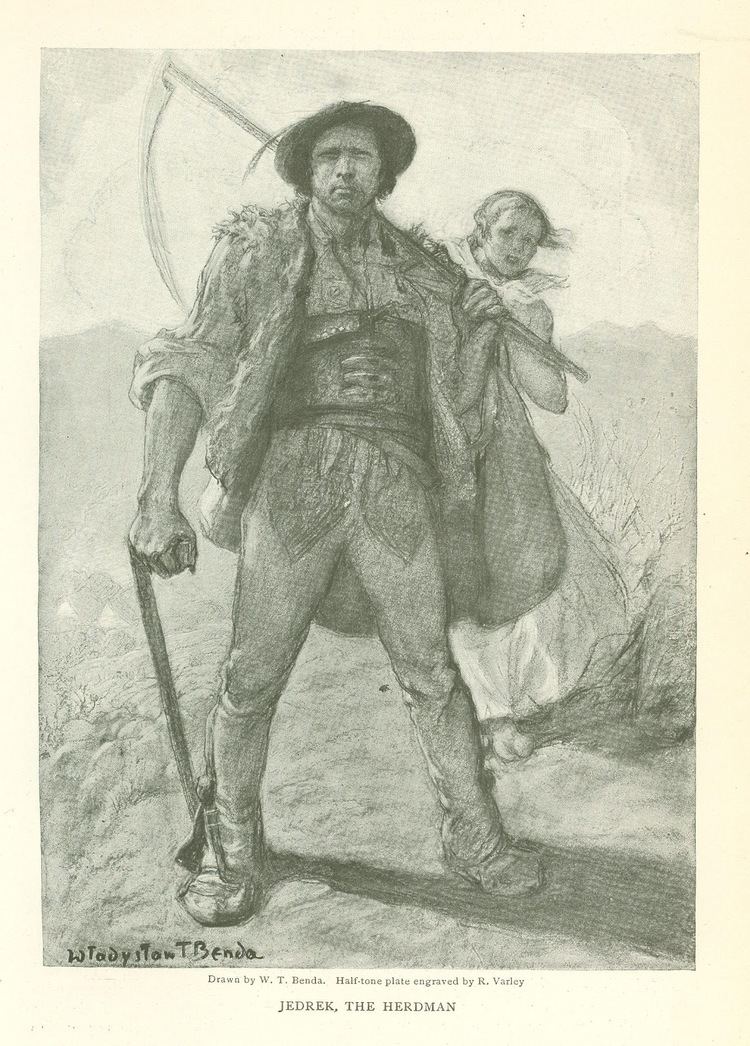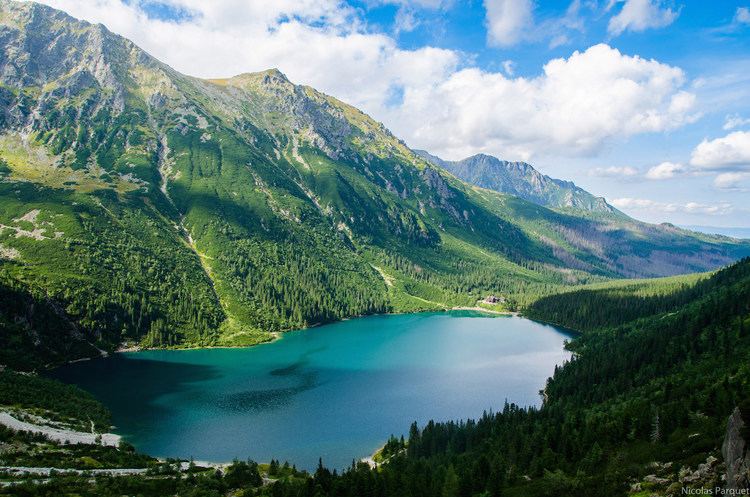Country Founded 17th century | Area 84 km2 Mayor Leszek Dorula | |
 | ||
Points of interest | ||
Map of Zakopane
Zakopane (pronounced [zakɔˈpanɛ]) is a town in the extreme south of Poland. It lies in the southern part of the Podhale region at the foot of the Tatra Mountains. From 1975 to 1998 it was in Nowy Sącz Province, but since 1999 it has been in Lesser Poland Province. It had a population of about 27,424 as of 2016. Zakopane is a center of Góral culture and is known informally as "the winter capital of Poland". It is a popular destination for mountaineering, skiing, and qualified tourism.
Contents
- Map of Zakopane
- My trip to morskie oko in zakopane poland 2015
- History
- Architecture
- Sports
- Mountaineering
- Skiing
- Tourism
- Twin towns
- Notable structures
- Notable residents
- Notable visitors
- References

Zakopane is located in southernmost Poland near the border with Slovakia. It lies in a valley between the Tatra Mountains and Gubałówka Hill. It can be reached by train or by bus from district capital Kraków, which is about two hours away. Zakopane has an elevation of 800-1,000 meters above sea level. The town is centered at the junction of Krupówki and Kościuszko Streets.

My trip to morskie oko in zakopane poland 2015
History
The earliest documents mentioning Zakopane date to the 17th century, describing a glade called Zakopisko. In 1676 it was a village of 43 inhabitants. In 1818 Zakopane was a small town that was still being developed. There were only 340 homes that held 445 families. The population of Zakopane at that time was 1,805. 934 women and 871 men lived in Zakopane. The first church was built in 1847, by Józef Stolarczyk. Zakopane became a center for the region's mining and metallurgy industries; in the 19th century, it was the largest center for metallurgy in Galicia. It expanded during the 19th century as the climate attracted more inhabitants. By 1889 it had developed from a small village into a climatic health resort. Rail service to Zakopane began October 1, 1899. In the late 1800's Zakopane constructed a road that went to the town of Nowy Targ, and railways that came from Chabówka. Because of easier transportation the population of Zakopane had increased to about 3,000 people by the end of the 1900s.In the 19th century, the Krupówki street was just a narrow beaten path that was meant for people to get from the central part of town to Kuźnice.
The ski jump on Wielka Krokiew was opened in 1925. The cable car to Kasprowy Wierch was completed in 1936. The funicular connected Zakopane and the top of Gubałówka in 1938.
Because of Zakopanes popular ski mountains, the town gained popularity this made the number of tourists increase to about 60,000 people by 1930.
In March 1940, representatives of the Soviet NKVD and the Nazi Gestapo met for one week in Zakopane's Villa Tadeusz, to coordinate the pacification of resistance in Poland. Throughout World War II, Zakopane served as an underground staging point between Poland and Hungary.
From 1942 to 1943, 1,000 prisoners from the German Kraków-Płaszów concentration camp were set to work in a stone quarry.
Architecture
The Zakopane Style of Architecture is an architectural mode inspired by the regional art of Poland’s highland region known as Podhale. Drawing on the motifs and traditions in the buildings of the Carpathian Mountains, the style was pioneered by Stanislaw Witkiewicz and is now considered a core tradition of the Góral people.
Sports
The Tatras are a popular destination among hikers, skiers, ski-tourers and climbers.
Mountaineering
There is a network of well marked hiking trails in the Tatras and according to the national park regulations the hikers must stick to them. Most of these trails are overcrowded, especially in the summer season.
The High Tatras offer excellent opportunities for climbing (up to X UIAA grade).
In summer, lightning and snow are both potential hazards for climbers, and the weather can change quickly. Thunderstorms are common in the afternoons. In winter the snow can be up to several meters deep.
Skiing
In the winter, thousands arrive in Zakopane to ski, especially around Christmas and in February. The most popular skiing areas are Kasprowy Wierch and Gubałówka. There are a number of cross country skiing trails in the forests surrounding the town.
Zakopane hosted the Nordic World Ski Championships in 1929, 1939, and 1962; the winter Universiades in 1956, 1993, and 2001; the biathlon World Championship; several ski jumping world cups; and several Nordic combined, Nordic and Alpine European Cups. It hosted the Alpine World Ski Championships in 1939, the first outside the Alps and the last official world championships prior to World War II.
Zakopane made unsuccessful bids to host the 2006 Winter Olympics and the 2011 and 2013 Alpine World Ski Championships.
Tourism
Zakopane is visited by over 2,500,000 tourists a year. In the winter, Zakopanes tourists are interested in winter sports activities such as skiing, snowboarding, ski jumping, snowmobiling, sleigh rides, snowshoe walks, and Ice skating. During the summer, Tourists come to do activities like hiking, climbing, bike and horse ride the Tatras mountain, there are many trails in the Tatras. Tourists ride quads and dirt bikes that you can rent. Swimming and boat rides on the Dunajec river is popular. Many come to experience góral culture, which is rich in its unique styles of food, speech, architecture, music, and costume. Zakopane is especially popular during the winter holidays, which are celebrated in traditional style, with dances, decorated horse-pulled sleighs called kuligs and roast lamb.
A popular tourist activity is taking a stroll through the town's most popular street: Krupówki. It is lined with stores, restaurants, carnival rides, and performers.
During the seasons winter and summer the Krupówki street gets crowded by tourists, these tourists visit shops and restaurants. In the summer time there is a local market down the strip of Krupówki. The people working in the market sell all kinds of clothing including leather jackets, traditional góral clothing, fur coats, shoes, and purses. Venders also sell foods like the famous smoked sheep cheese Oscypek, fruits, vegetables, and meats. There are also a lot of stands that sell all kinds of Zakopane souvenirs.
Zakopane is popular for night life. At night there are always people walking around town checking out the different bars and dance clubs. Most of these bars and dance clubs are located on the Krupowki street. These are the bars that are located in Zakopane: Paparazzi, Cafe Piano, Anemone, Anemone, Cafe Antrakt, Literatka, Winoteka Pod Berlami, and Karczma u Ratownikow. These are dance clubs located in Zakopane: Vavaboom, Finlandia Arctic, Genesis, Rockus, Morskie Oko, and Cocomo Go Go Club.[2]
A scene in Andrzej Wajda's film Man of Marble (Człowiek z marmuru) was filmed in Zakopane, introducing the town to a worldwide audience.
The mountain scenes from the Bollywood film Fanaa were filmed around Zakopane.
Twin towns
Zakopane participates in town twinning to foster international links.
